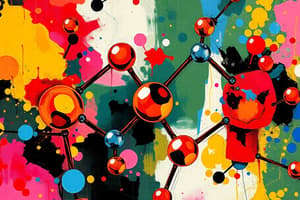Podcast
Questions and Answers
What is the hybridization of a carbon atom that is bonded to three other atoms and has no lone pairs?
What is the hybridization of a carbon atom that is bonded to three other atoms and has no lone pairs?
- sp
- sp³ (correct)
- sp³d
- sp²
Which of the following hybridizations includes a carbon atom with one double bond?
Which of the following hybridizations includes a carbon atom with one double bond?
- sp³d
- sp
- sp² (correct)
- sp³
How is sp hybridization characterized in terms of bonding?
How is sp hybridization characterized in terms of bonding?
- One single bond and one double bond
- One triple bond and two lone pairs (correct)
- Two single bonds and one triple bond
- Two double bonds and one single bond
Which functional group typically indicates the presence of a double bond in organic compounds?
Which functional group typically indicates the presence of a double bond in organic compounds?
What is the primary distinction between sp² and sp³ hybridization?
What is the primary distinction between sp² and sp³ hybridization?
What is the main factor that distinguishes saturated hydrocarbons from unsaturated hydrocarbons?
What is the main factor that distinguishes saturated hydrocarbons from unsaturated hydrocarbons?
In the context of organic compounds, what does the degree of unsaturation indicate?
In the context of organic compounds, what does the degree of unsaturation indicate?
What is the implication of a compound having a high degree of unsaturation?
What is the implication of a compound having a high degree of unsaturation?
Which type of compound typically contains spiro structures?
Which type of compound typically contains spiro structures?
When determining IUPAC names, what role does the degree of unsaturation play?
When determining IUPAC names, what role does the degree of unsaturation play?
Flashcards are hidden until you start studying
Study Notes
Understanding Hydrocarbons and Their Structure
- Hydrocarbons are organic compounds consisting solely of hydrogen and carbon atoms.
- They can be classified into saturated (alkanes) and unsaturated (alkenes and alkynes) based on the presence of double or triple bonds.
- The general formula for alkanes is CnH2n+2, for alkenes is CnH2n, and for alkynes is CnH2n-2.
Determining Hybridization of Carbon Atoms
- Hybridization describes the mixing of atomic orbitals to form new hybrid orbitals for bonding.
- The hybridization of a carbon atom can be established by the number of sigma (σ) bonds and lone pairs it has.
- Carbon atoms can exhibit sp³ hybridization (four sigma bonds, typically in alkanes), sp² hybridization (three sigma bonds and one double bond, seen in alkenes), or sp hybridization (two sigma bonds and one triple bond, found in alkynes).
Functional Groups and Their Role in Compound Classification
- Functional groups are specific groups of atoms within molecules that determine the chemical properties of those compounds.
- Common functional groups include hydroxyl (-OH), carboxyl (-COOH), amino (-NH2), and aldehyde (-CHO).
- The presence of functional groups enables the classification of compounds, influencing their reactivity, polarity, and solubility characteristics.
Understanding Hydrocarbons and Their Structure
- Hydrocarbons are organic compounds consisting solely of hydrogen and carbon atoms.
- Two main categories: saturated hydrocarbons (alkanes), which contain only single bonds, and unsaturated hydrocarbons (alkenes and alkynes), which include double or triple bonds.
Identifying Saturated and Unsaturated Hydrocarbons
- Saturated hydrocarbons, like alkanes, have the general formula CnH2n+2.
- Unsaturated hydrocarbons are characterized by having fewer hydrogen atoms due to the presence of double (C=C) or triple bonds (C≡C).
- Chemical tests, such as bromine water or acidity tests, can help identify saturation levels.
Calculating the Degree of Unsaturation in Organic Compounds
- Degree of unsaturation (DU) indicates the total number of rings and multiple bonds in a compound.
- Calculation: DU = (2C + 2 - H - X) / 2, where C = number of carbons, H = number of hydrogens, and X = halogens.
- Each degree of unsaturation corresponds to one ring or one double bond.
Understanding Spiro Compounds and Their Degree of Unsaturation
- Spiro compounds contain two or more rings that share one or more carbon atoms.
- The degree of unsaturation for spiro compounds can be calculated by considering shared carbons to determine their number of rings.
Relationship Between Degree of Unsaturation and Pi Bonds
- Increased degree of unsaturation often indicates the presence of pi bonds in the molecule.
- Each pi bond reduces the number of hydrogen atoms compared to saturated counterparts.
Applying Degree of Unsaturation to IUPAC Naming
- Degree of unsaturation affects the IUPAC nomenclature by providing information about the structure of the compound.
- Recognizing how many pi bonds and rings are present helps in assigning the correct name according to IUPAC rules.
Studying That Suits You
Use AI to generate personalized quizzes and flashcards to suit your learning preferences.



